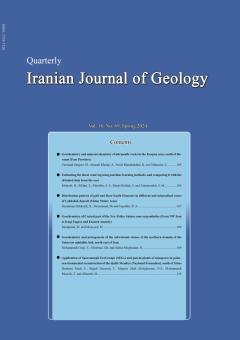تخمین لاگ صوتی برشی با استفاده از روشهای یادگیری ماشین، و مقایسه با دادههای حاصل از مغزه
الموضوعات :
هوشنگ مهرابی
1
![]() ,
ابراهیم سفیداری
2
,
سیده سپیده میرربیع
3
,
صادق براتی بلداجی
4
,
سید محمد زمانزاده
5
,
ابراهیم سفیداری
2
,
سیده سپیده میرربیع
3
,
صادق براتی بلداجی
4
,
سید محمد زمانزاده
5
1 - گروه زمینشناسی نفت، پژوهشکده علوم پایه کاربردی، جهاد دانشگاهی ، تهران، ایران
2 - استادیار گروه زمینشناسی نفت، پژوهشکده علوم پایه کاربردی، جهاد دانشگاهی شهید بهشتی، تهران، ایران
3 - دانش آموخته کارشناسی ارشد، دانشکده زمینشناسی، پردیس علوم، دانشگاه تهران، تهران، ایران
4 - کارشناس ارشد، گروه زمینشناسی نفت، پژوهشکده علوم پایه کاربردی، جهاد دانشگاهی شهید بهشتی، تهران، ایران
5 - دانشگاه تهران
الکلمات المفتاحية: پایتون, تخمین, لاگ صوتی برشی, یادگیری ماشین,
ملخص المقالة :
امروزه استفاده از روشهای یادگیری ماشین در تخمین دادههای پتروفیزیکی کاربرد فراوانی دارد. در این مطالعه سعی شده لاگ صوتی برشی از دیگر دادههای پتروفیزیکی با روشهای یادگیری ماشین محاسبه و با دادههای صوتی حاصل از مغزه مقایسه شوند. برای این منظور در ابتدا برای نرمالسازی دادهها روشهای محاسباتی انحراف معیار، جنگل انزوا، حداقل کوواریانس و فاکتور پرتی استفاده و مورد مقایسه قرار گرفتند. با توجه به مقدار دادههای حذفی و نمودارهای جعبهای رسم شده، روش انحراف معیار برای نرمالسازی انتخاب شد. روشهای یادگیری ماشین استفاده شده شامل جنگل تصادفی، رگرسیون چندگانه، رگرسیون تقویت شده، رگرسیون بردار پشتیبان، K نزدیکترین همسایه و پرسپترون چندلایه میباشند. رگرسیون چندگانه پایینترین اندیس ارزیابی (94/0 = R2) را داشت درحالیکه رگرسیون جنگل تصمیمگیری با اندیس ارزیابی برابر 98/0، بالاترین همبستگی بین لاگهای صوتی برشی تخمین زده شده و لاگ صوتی اصلی را داشتند. بنابراین برای تخمین نهایی از رگرسیون جنگل تصادفی استفاده شد و برای جلوگیری از کلیت بخشی یا بیش برازش دادهها، از تابع GridSearchCV هایپرپارامترهای بهینه محاسبه و تخمین نهایی انجام شد. لاگ صوتی برشی تخمینی، با دادههای صوتی حاصل از مغزه قرابت بسیار بالایی را نشان دادند.
Akhundi, H., Ghafoori, M. and Lashkaripour, G.R., 2014. Prediction of shear wave velocity using artificial neural network technique, multiple regression and petrophysical data: A case study in Asmari reservoir (SW Iran). Open Journal of Geology, 4, 303-313. Doi: https://10.4236/ojg.2014.47023
Anemangely, M., Ramezanzadeh, A. and Behboud, M.M., 2019. Geomechanical parameter estimation from mechanical specific energy using artificial intelligence. Journal of Petroleum Science and Engineering, 175, 407-429. Doi: https://doi.org/10.1016/j.petrol.2018.12.054
Breiman, L., 2001. Random forests. Machine learning, 45(1), 5-32. Doi: https://doi.org/10.1023/A:1010933404324
Eskandari, H., Rezaee, M.R. and Mohammadnia, M., 2004. Application of multiple regression and artificial neural network techniques to predict shear wave velocity from wireline log data for a carbonate reservoir South-West Iran. CSEG recorder, 42, 40-48.
Fjaer, E., Holt, R.M., Horsrud, P. and Raaen, A.M., 2008. Petroleum Related Rock Mechanics. Elsevier Science Publisher: Amsterdam, The Netherlands.
Forkuor, G., Hounkpatin, O.K., Welp, G. and Thiel, M., 2017. High resolution mapping of soil properties using remote sensing variables in south-western Burkina Faso: a comparison of machine learning and multiple linear regression models. PloS one, 12(1), p.e0170478. Doi: https://doi.org/10.1371/journal.pone.0170478
Goldberger, A.S., 1962. Best linear unbiased prediction in the generalized linear regression model. Journal of the American Statistical Association, 57(298), 369-375. Doi: https://doi.org/10.1080/01621459.1962.10480665
Heiat, A., 2002. Comparison of artificial neural network and regression models for estimating software development effort. Information and software Technology, 44(15), 911-922. Doi: https://doi.org/10.1016/S0950-5849(02)00128-3
McGregor, A., Hall, M., Lorier, P. and Brunskill, J., 2004. Flow clustering using machine learning techniques. In Passive and Active Network Measurement: 5th International Workshop, PAM 2004, Antibes Juan-les-Pins, France, April 19-20, 2004. Proceedings 5, 205-214. Springer Berlin Heidelberg.
Rajabi, M., Bohloli, B. and Ahangar, E.G., 2010. Intelligent approaches for prediction of compressional, shear and Stoneley wave velocities from conventional well log data: A case study from the Sarvak carbonate reservoir in the Abadan Plain (Southwestern Iran). Computers & Geosciences, 36(5), 647-664. Doi: https://doi.org/10.1016/j.cageo.2009.09.008
Ramcharitar, K. and Hosein, R., 2016, June. Rock Mechanical Properties of Shallow Unconsolidated Sandstone Formations. Paper presented at the SPE Trinidad and Tobago Section Energy Resources Conference, Port of Spain, Trinidad and Tobago. Doi: https://doi.org/10.2118/180803-MS
Hosseini, Z., Gharechelou, S., Mahboubi, A., Moussavi-Harami, R., Kadkhodaie-Ilkhchi, A., and Zeinali, M., 2021, Shear wave velocity estimation utilizing statistical and multi-intelligent models from petrophysical data in a mixed carbonate-siliciclastic reservoir, SW Iran. Iranian Journal of Oil and Gas Science and Technology, 10(1), 15-39. doi: https://10.22050/ijogst.2020.241095.1556
Steinwart, I. and Christmann, A., 2008. Support vector machines. Springer Science and Business Media.
Tariq, Z., Elkatatny, S.M., Mahmoud, M.A., Abdulraheem, A., Abdelwahab, A.Z. and Woldeamanuel, M., 2017, June. Estimation of Rock Mechanical Parameters Using Artificial Intelligence Tools. In ARMA US Rock Mechanics/Geomechanics Symposium (ARMA-2017). ARMA.
Tixier, M.P., Loveless, G.W. and Anderson, R.A., 1975. Estimation of formation strength from the mechanical-properties log (incudes associated paper 6400). Journal of Petroleum Technology, 27(03), 283-293. Doi: https://doi.org/10.2118/4532-PA
Xu, Y., Zhang, H. and Guan, Z., 2021. Dynamic characteristics of downhole bit load and analysis of conversion efficiency of drill string vibration energy. Energies, 14(1), 229. Doi: https://doi.org/10.3390/en14010229
Zou, X., 2019. Application of machine learning in shear wave prediction of jiaoshiba shale gas horizontal well. Jianghan Petroleum Science and Technology, 29(4), 16-22.
Kuzmanovski, I. and Aleksovska, S., 2003. Optimization of artificial neural networks for prediction of the unit cell parameters in orthorhombic perovskites. Comparison with multiple linear regression. Chemometrics and Intelligent Laboratory Systems, 67(2), pp.167-174.


